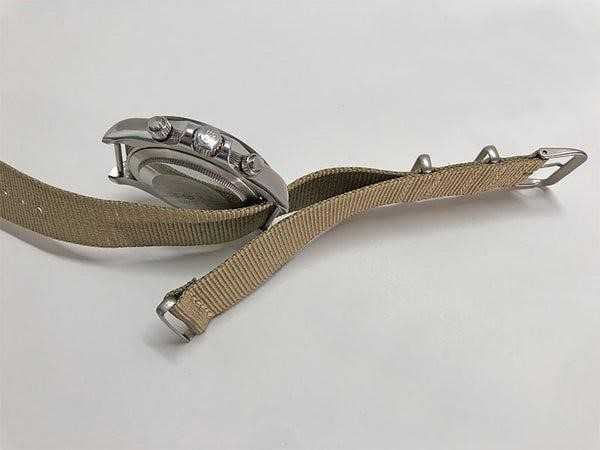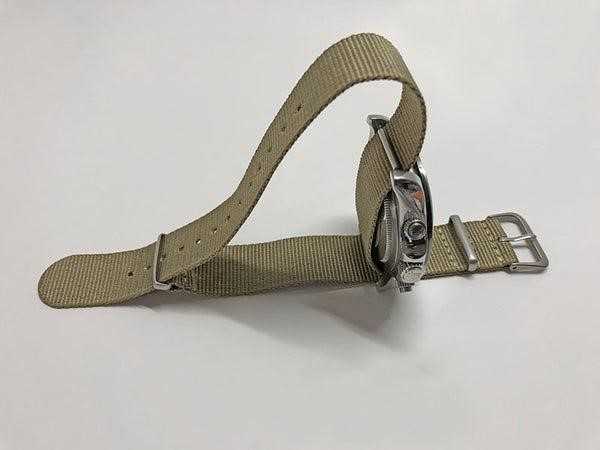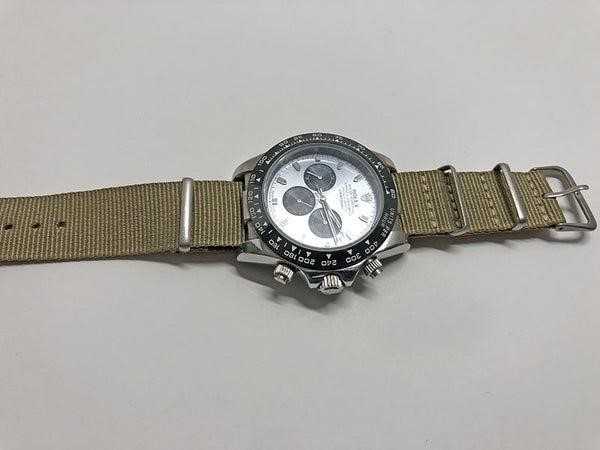What is a NATO WatchStrap?
In 1973, the British Ministry of Defense introduced the first NATO for its soldiers to use in the field. It had the name “G10,” as soldiers wanting to get one had to fill out G1098 requisition form. The NSN (NATO Stock Number) used while ordering the strap inspired the term “NATO.” The 20mm nylon band was lightweight and breathable, and it prevented the watch from sliding over the wearer’s wrist. The strap became a symbol of austere roughness and simple reliability among the British Special Forces. But it took a different British icon to catapult the NATO strap into superstardom.
In 1962, James Bond aka Sean Connery, was wearing a Rolex Submariner Ref.: 6538 in the movie “Dr. No”. Besides Breitling, TagHeuer and even digital Seiko watches, agent 007 was wearing a Rolex watch in 8 Bond movies until 1989. The first close-up of James Bond’s watch was seen in the movie “Goldfinger” and remains the definitive “Bond watch” to many watch fans even decades later. Besides that Bond watches became famous for their special gadgets such as; Circular-saw-bezel, welding-laser 12 o’clock marking point, or grappling hook shot from the crown – the early watches became famous for their military inspired NATO straps in the typical black/red/green color combination.

The NATO watchstrap is a single piece of material that slips between the watch face’s lugs, under the caseback, doubling back on itself, and secures by way of a buckle closure. Because of the “caseback double-back,” the watch stays centered and secure on the wrist. Even if one of the lugs were to fail, the watch would remain on the band. The end of the strap is left intentionally long, giving you the ability to fold that back on itself and doubling the band’s on-wrist security.
NATO watchstrap – Pros and Cons
Pros:
- Comfortable, sits well on wrist, lightweight: Every watch is comfortable on a NATO strap, that’s just fact. Even tight weave NATO’s that may be a little firm in their early days soon soften to become supremely comfortable. They’re incredibly lightweight and feel like they take all the weight out of the watch.
- Affordable price: A price for a high quality NATO watchstrap from $29 to $39 is the fairest. (However, It isn’t the best idea to wear the cheapest NATO straps available in the world wide web on your wristwatch; The nylon used for cheap NATO straps can be very stiff, and can have a slippery touch, because of the low quality nylon used. Sometimes they even can have an annoying chemical smell. Attributes of cheap NATO straps really don’t suit an exclusive watch. Another point is the hardware on cheap NATO straps. Most often they’re made of cheap metals, or even plastic and poorly plated. The chrome will easily wear off and the brass will come through. This is not the kind of strap your watch deserves. Choose your straps wisely)
- Super secure: Another important fact is that the watch sits safe “between” the NATO strap. It’s pulled through the spring bars and again pulled through another stainless steel loop. If the very rare case of spring bar failure occurs, the watch will still hang on its last spring bar between the strap and it won’t fall off your wrist.
- Perfect for outdoor activities and are easy to clean: NATO straps are made of nylon webbing, just like your polyester sport shirt. Both belong to the family of synthetic polymers and just like your sport shirt, a NATO strap dries quickly. As a result, you won’t have any trouble swimming or diving with it. It can even be worn over a diving suit due to its length. It’s drying more quickly than leather, canvas or cotton watch straps. If a NATO strap is rigid at first, it will get softer after a while, depending on the thickness of the strap you choose. While 1,2 mm straps are supple right away, 1,4 mm straps require a little more time of wearing.
Because they have the safety attributes and dry quick, it’s the perfect strap for any outdoor- or sport activity. Compared to leather straps, NATO straps are resistant to sweat and dirt and easy to clean. Just clean it with soap and water, or it can be simply washed in the washing machine. (But better put the strap into a pocket of pants or small bag, so the buckle is not harming the machine or other clothes)
Cons:
- Not for formal event: They’re not ideal for a dress watch or more sophisticated model. If you are choosing a watch strap for a formal occasion such as a business meeting or a luxurious party, you can consider stainless steel or leather watch straps.
- NATO watchstrap can become worn with use, edges may fray.
2 types of NATO watchstrap
NATO watchstrap is divided into 2 types: Single-piece NATO straps and Two-piece NATO strap
Pros & Cons of single-piece NATO straps
Pros
- It’s the “original” NATO strap
- Military, sporty look
- If one spring bar fails, the watch doesn’t fall off the wrist
- Easy to swap
Cons
- Bulky strap leftover on the side of the wrist
- The very sporty “military” style may not fit to a lot of outfits
- The watch sits 2,4-2,8 mm higher on your wrist
Pros & Cons if two-piece NATO straps
Pros
- No bulky leftover on the side or unter the wrist
- The classic style of a two-piece strap suits most outfits
- A see through case back isn’t covered
- The thickness of 3 mm is perfect for sport watches
- No additional height of your watch
Cons
- The thickness of 3 mm might not suit slim watches
- If the very rare case of a spring bar failure occurs, the watch can fall off the wrist
- You need spring bar tool to swap the strap
How to put on a NATO watchstrap
Now that you have removed the NATO watchstrap from the case, make sure that you have reinstalled just the spring bars or pins to the watch case. Once that is done take the NATO strap from its packaging. Notice that the strap loops through one of the keepers. Remove the “tongue” of the strap from that keeper.

The NATO watchstrap’s buckle side will be on the 12 o’clock side of the watch. Slide the “tongue” of the strap through the 12 o’clock side of the watch case. The NATO strap should slide into the lugs perfectly and sit in between the spring bars and the watch case itself.

Now, take the NATO strap’s “tongue” that remains and slide it through the 6 o’clock side of the watch case. The NATO should slide again inbetween the watch case and the spring bar. Push the watch case up to the strap, in the direction of the 12 o’clock marker.

The loop or keeper that is hanging out the rear of the case of the watch must be attached back to ensure the watch stays in position. Slide the Tongue of the NATO strap through the keeper you originally took it out of.

Again, take a look at the watch and make sure that the buckle side of the NATO strap is on the 12 o’clock side of the watch.

Now it is time to wear the watch. Put the watch and NATO strap on your wrist, run the tongue side through the buckle and adjust it to a comfortable position.

The next picture shows how to insert the tongue into the keepers. Now you have created the ultimate NATO military strap look.



Finally, let’s enjoy your new NATO watchstrap!

